Chengbo Zheng
Supporting Data-Frame Dynamics in AI-assisted Decision Making
Apr 22, 2025Abstract:High stakes decision-making often requires a continuous interplay between evolving evidence and shifting hypotheses, a dynamic that is not well supported by current AI decision support systems. In this paper, we introduce a mixed-initiative framework for AI assisted decision making that is grounded in the data-frame theory of sensemaking and the evaluative AI paradigm. Our approach enables both humans and AI to collaboratively construct, validate, and adapt hypotheses. We demonstrate our framework with an AI-assisted skin cancer diagnosis prototype that leverages a concept bottleneck model to facilitate interpretable interactions and dynamic updates to diagnostic hypotheses.
* Presented at the 2025 ACM Workshop on Human-AI Interaction for Augmented Reasoning, Report Number: CHI25-WS-AUGMENTED-REASONING
DiscipLink: Unfolding Interdisciplinary Information Seeking Process via Human-AI Co-Exploration
Aug 01, 2024



Abstract:Interdisciplinary studies often require researchers to explore literature in diverse branches of knowledge. Yet, navigating through the highly scattered knowledge from unfamiliar disciplines poses a significant challenge. In this paper, we introduce DiscipLink, a novel interactive system that facilitates collaboration between researchers and large language models (LLMs) in interdisciplinary information seeking (IIS). Based on users' topics of interest, DiscipLink initiates exploratory questions from the perspectives of possible relevant fields of study, and users can further tailor these questions. DiscipLink then supports users in searching and screening papers under selected questions by automatically expanding queries with disciplinary-specific terminologies, extracting themes from retrieved papers, and highlighting the connections between papers and questions. Our evaluation, comprising a within-subject comparative experiment and an open-ended exploratory study, reveals that DiscipLink can effectively support researchers in breaking down disciplinary boundaries and integrating scattered knowledge in diverse fields. The findings underscore the potential of LLM-powered tools in fostering information-seeking practices and bolstering interdisciplinary research.
Towards Human-AI Deliberation: Design and Evaluation of LLM-Empowered Deliberative AI for AI-Assisted Decision-Making
Mar 25, 2024



Abstract:In AI-assisted decision-making, humans often passively review AI's suggestion and decide whether to accept or reject it as a whole. In such a paradigm, humans are found to rarely trigger analytical thinking and face difficulties in communicating the nuances of conflicting opinions to the AI when disagreements occur. To tackle this challenge, we propose Human-AI Deliberation, a novel framework to promote human reflection and discussion on conflicting human-AI opinions in decision-making. Based on theories in human deliberation, this framework engages humans and AI in dimension-level opinion elicitation, deliberative discussion, and decision updates. To empower AI with deliberative capabilities, we designed Deliberative AI, which leverages large language models (LLMs) as a bridge between humans and domain-specific models to enable flexible conversational interactions and faithful information provision. An exploratory evaluation on a graduate admissions task shows that Deliberative AI outperforms conventional explainable AI (XAI) assistants in improving humans' appropriate reliance and task performance. Based on a mixed-methods analysis of participant behavior, perception, user experience, and open-ended feedback, we draw implications for future AI-assisted decision tool design.
Charting the Future of AI in Project-Based Learning: A Co-Design Exploration with Students
Jan 29, 2024



Abstract:The increasing use of Artificial Intelligence (AI) by students in learning presents new challenges for assessing their learning outcomes in project-based learning (PBL). This paper introduces a co-design study to explore the potential of students' AI usage data as a novel material for PBL assessment. We conducted workshops with 18 college students, encouraging them to speculate an alternative world where they could freely employ AI in PBL while needing to report this process to assess their skills and contributions. Our workshops yielded various scenarios of students' use of AI in PBL and ways of analyzing these uses grounded by students' vision of education goal transformation. We also found students with different attitudes toward AI exhibited distinct preferences in how to analyze and understand the use of AI. Based on these findings, we discuss future research opportunities on student-AI interactions and understanding AI-enhanced learning.
Competent but Rigid: Identifying the Gap in Empowering AI to Participate Equally in Group Decision-Making
Feb 17, 2023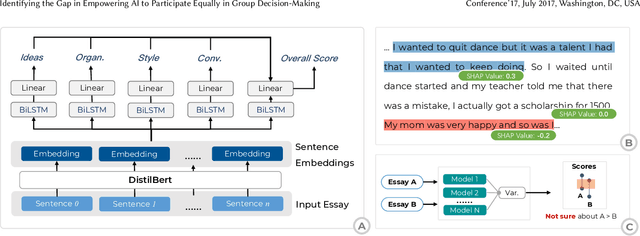

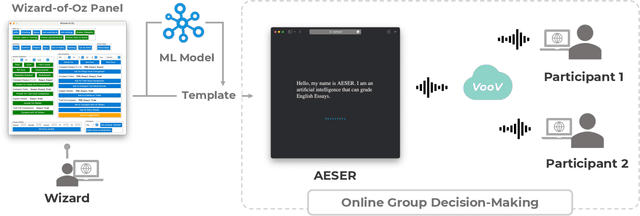
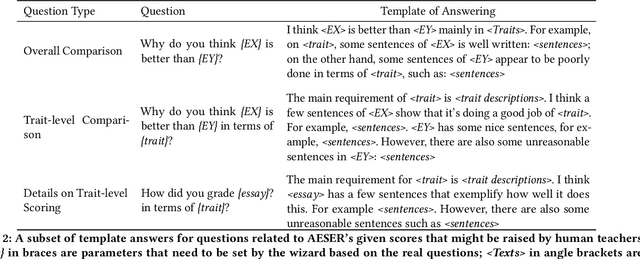
Abstract:Existing research on human-AI collaborative decision-making focuses mainly on the interaction between AI and individual decision-makers. There is a limited understanding of how AI may perform in group decision-making. This paper presents a wizard-of-oz study in which two participants and an AI form a committee to rank three English essays. One novelty of our study is that we adopt a speculative design by endowing AI equal power to humans in group decision-making.We enable the AI to discuss and vote equally with other human members. We find that although the voice of AI is considered valuable, AI still plays a secondary role in the group because it cannot fully follow the dynamics of the discussion and make progressive contributions. Moreover, the divergent opinions of our participants regarding an "equal AI" shed light on the possible future of human-AI relations.
Who Should I Trust: AI or Myself? Leveraging Human and AI Correctness Likelihood to Promote Appropriate Trust in AI-Assisted Decision-Making
Jan 14, 2023
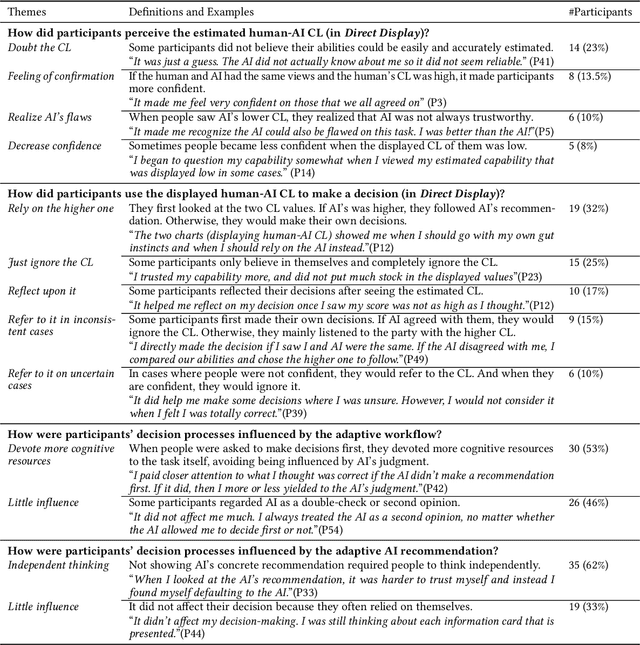

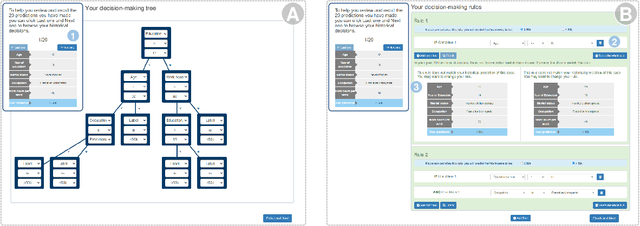
Abstract:In AI-assisted decision-making, it is critical for human decision-makers to know when to trust AI and when to trust themselves. However, prior studies calibrated human trust only based on AI confidence indicating AI's correctness likelihood (CL) but ignored humans' CL, hindering optimal team decision-making. To mitigate this gap, we proposed to promote humans' appropriate trust based on the CL of both sides at a task-instance level. We first modeled humans' CL by approximating their decision-making models and computing their potential performance in similar instances. We demonstrated the feasibility and effectiveness of our model via two preliminary studies. Then, we proposed three CL exploitation strategies to calibrate users' trust explicitly/implicitly in the AI-assisted decision-making process. Results from a between-subjects experiment (N=293) showed that our CL exploitation strategies promoted more appropriate human trust in AI, compared with only using AI confidence. We further provided practical implications for more human-compatible AI-assisted decision-making.
Telling Stories from Computational Notebooks: AI-Assisted Presentation Slides Creation for Presenting Data Science Work
Mar 21, 2022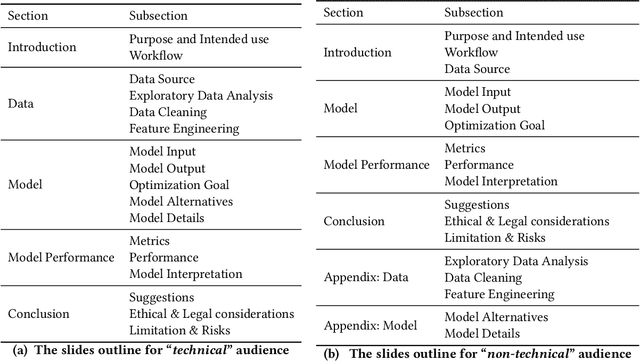
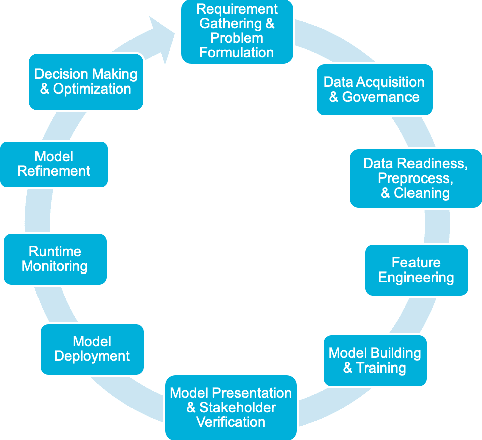
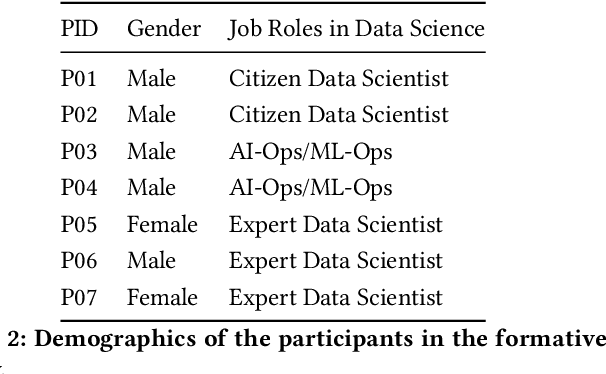
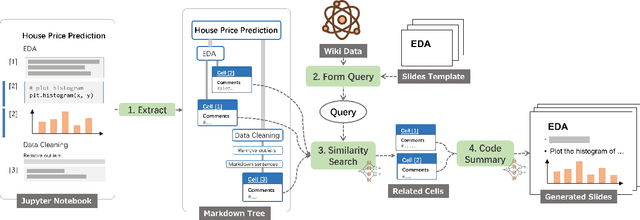
Abstract:Creating presentation slides is a critical but time-consuming task for data scientists. While researchers have proposed many AI techniques to lift data scientists' burden on data preparation and model selection, few have targeted the presentation creation task. Based on the needs identified from a formative study, this paper presents NB2Slides, an AI system that facilitates users to compose presentations of their data science work. NB2Slides uses deep learning methods as well as example-based prompts to generate slides from computational notebooks, and take users' input (e.g., audience background) to structure the slides. NB2Slides also provides an interactive visualization that links the slides with the notebook to help users further edit the slides. A follow-up user evaluation with 12 data scientists shows that participants believed NB2Slides can improve efficiency and reduces the complexity of creating slides. Yet, participants questioned the future of full automation and suggested a human-AI collaboration paradigm.
 Add to Chrome
Add to Chrome Add to Firefox
Add to Firefox Add to Edge
Add to Edge